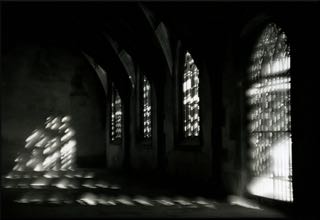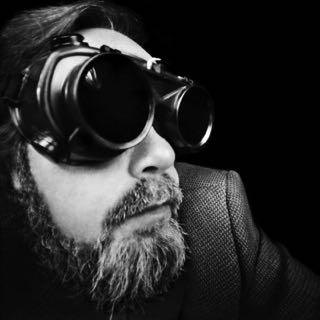While I’ve been photographing for over 20 years now, I’ve only been using pinhole cameras for the last 7 or 8 years. I still remember the images that inspired me to pick up the pinhole camera and give it a try – many of those images were produced by Scott Speck.
Naturally, when I started this blog and started considering the idea of interviewing other photographers, the first photographer that came to mind was Scott. If you’ve been paying attention to pinhole photography for much time at all, you’ve likely seen his work before.
Scott Speck has been making pinhole photographs since 2006, but his photographic experience goes back further than that. He has a reputation for using angles and perspective in conjunction with precise lighting to produce dramatic images of spaces and people.
I caught up with Scott over email and got the chance to ask him about where his vision has been and where it’s going.
You’ve been focused on pinhole photography since 2006, but looking at your earliest flickr photos there’s a fair amount of lens work in there too. What led to your transition to pinhole as your primary medium?
I bought a Zero Image 2000 6x6cm pinhole camera, and my wife and I experimented with it at an old, abandoned industrial site. The pinhole’s limitless depth of field, revealed on the black/white negatives, instantly captivated me. Further experimentation, including with the Zero Image 4×5 camera, with its ultrawide field of view, completely sold me on pinhole photography. [The Zero Image 4×5] became my camera of choice, especially considering the choice of three focal lengths, as well as both pinhole and zone plate options, with a single camera.
[singlepic id=34]The Archives, ©Scott Speck 2015[/singlepic]
Many of your most iconic images tend to apply pinhole’s unique ability to stretch a perspective to massive buildings and spaces such as cathedrals. Did you go looking for a medium that could fulfill your vision with these structures? Or was it a vision that you realized once you understood pinhole?
That’s a very good question… The answer is — I discovered my love of ultrawide photography through the Zero Image 4×5 camera. Since that time, I’ve used other ultrawide pinhole cameras, as well as an ultrawide lens on my dslr (which is not nearly as wide as the Zero 4×5).
[singlepic id=33]St. Nicholas Cathedral, ©Scott Speck 2015[/singlepic]
You’ve shown your work at exhibitions. How do your viewers tend to react when they understand that the image they’re looking at was made with a tiny tiny hole?
People are always amazed at what can be done with a such a simple camera! However, nowadays I try to let my photos “stand on their own”, since I don’t want my photos to be appreciated “just because they’re pinhole”. I want to create dramatic and meaningful photographs, with the pinhole medium merely being my means of achieving that goal. At the same time, I describe pinhole cameras and techniques to people, as a way to show them why I work in this medium, and of its unique capability and simplicity of use.
[singlepic id=32]Sky Light, ©Scott Speck 2015[/singlepic]
I’ve often found that when out shooting with a pinhole camera, I get a lot of questions and interactions from passersby. I doubt this experience is unique to me. Any noteworthy anecdotes?
A lot of people are curious, many of whom recognize that I’m shooting with a pinhole camera. I meet many people who have done large format film photography and share some of their own experiences with me. One unique experience was when I was shooting in Madrid, Spain, and a fellow came up to me and instantly fell in love with the Zero 2000 camera. He said he had just gone through a terrible divorce, and he was going to buy a Zero 2000 to create something and renew his enjoyment of life.
[singlepic id=35]The Mad Scientist…, ©Scott Speck 2015[/singlepic]
Your day job is as a modeling and simulation engineer at Johns Hopkins, and you’ve contributed to the Hubble and Webb space telescopes. One would guess that this experience helps shape the precision by which you shoot. How would you characterize the way your career has influenced your photography?
I think the precision and “math” that I use in doing my photography is enhanced by my scientific work. However, my love of beautiful imagery goes much farther back, to when I was very young and, using binoculars and telescopes, loved to view nature, as well as a massive steel/iron works just across the river from my house. I would sit for hours and immerse myself in scenes of brilliant gold finches roosting in a blossoming cherry tree, or of streams of molten iron being cast from inside a row of massive blast furnaces. I immediately felt the power of viewing and “capturing” images. I feel that I do well at my professional career, in part, because of my photography, and vice versa.
[singlepic id=29]B-47 Stratojet Engine, ©Scott Speck 2015[/singlepic]
Another aspect of your photography is the amount of portraiture you do. What challenges do you face in pinhole portraiture?
Pinhole portraiture is a challenge because of my desire to create a clear image of my subject, particular with indoor lighting. One problem this presents is the use of distractingly bright lighting, as well as the restrictions on subject position and facial expression.
[singlepic id=30]Dan the Man, ©Scott Speck 2015[/singlepic]
What do you find to be the most exciting direction in pinhole photography today?
The sheer number of techniques and camera types blow me away. The imagination of people enables new ways of recording images through the pinhole, including blending cameras, anamorphic cameras, and many others. I think it’s that huge diversity of techniques, all of which result in stunning imagery, that excites me the most.
[singlepic id=28]At the Helm, ©Scott Speck 2015[/singlepic]
What do you find yourself exploring most with your camera these days?
These days, I feel myself drawn to smaller scenes, and to intimate details and fields of view that impart a strong sense of atmosphere and mood. Examples would be wet autumn leaves in a puddle during a heavy rain, or the colorful gravel and sand on a beach rendered with stunning clarity, while the clouds and horizon are also in focus. I think I’m coming back more to where I started with the pinhole — a sense of tactile realness — a different way to view the world.
[singlepic id=31]Forest On a Rainy Day, ©Scott Speck 2015[/singlepic]
Many thanks to Scott for providing well rounded answers to our probing questions! You can learn more about Scott at his website and see more of his images on his Flickr page. I’d also recommend checking out his contributions to The Next Best Thing Pinhole Project.









